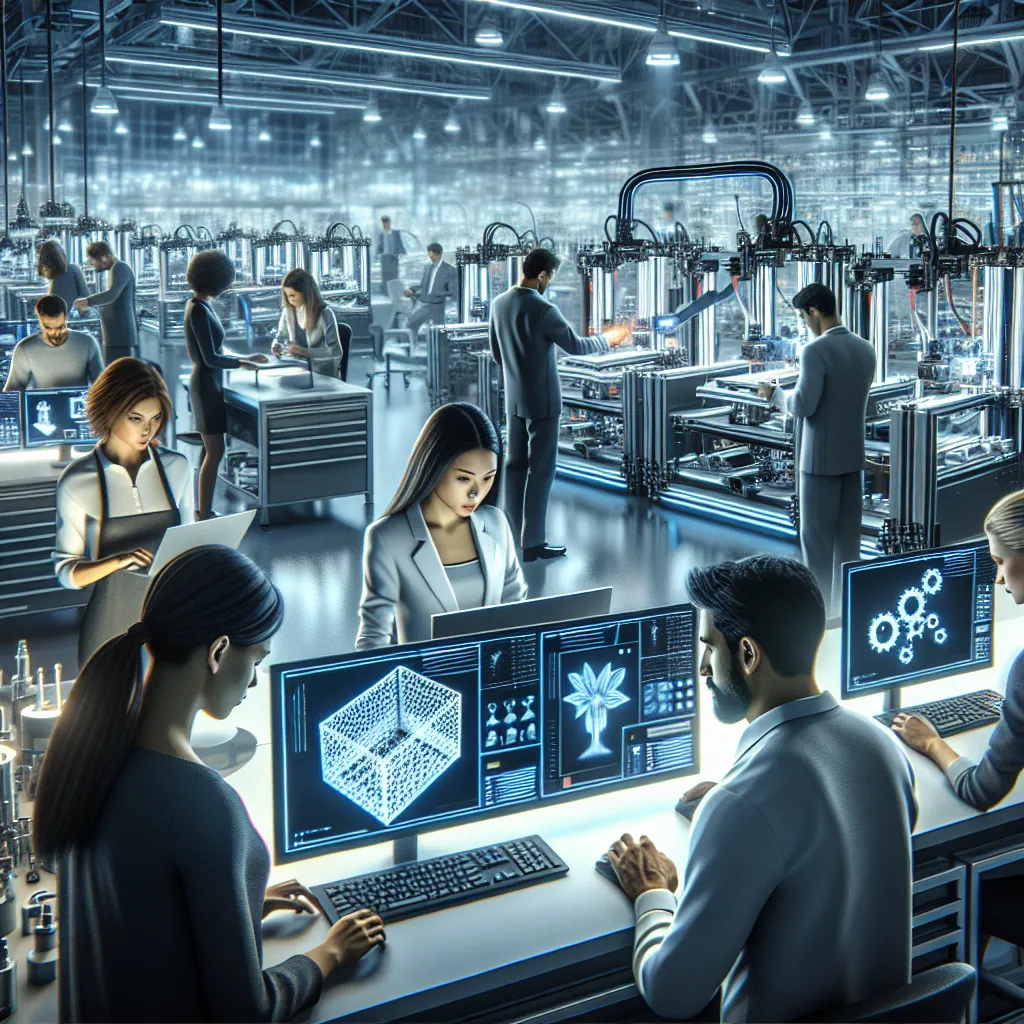Welcome to our IELTS Reading practice session focused on “The Future of 3D Printing in Manufacturing”. As an experienced IELTS instructor, I’m here to guide you through this comprehensive practice test that mirrors the actual IELTS exam structure. This exercise will not only enhance your reading skills but also broaden your knowledge about cutting-edge manufacturing technologies.
 3D printing revolutionizing manufacturing
3D printing revolutionizing manufacturing
IELTS Reading Test: The Future of 3D Printing in Manufacturing
Passage 1 – Easy Text
The Rise of 3D Printing in Manufacturing
3D printing, also known as additive manufacturing, has emerged as a groundbreaking technology in the manufacturing sector. Unlike traditional manufacturing methods that involve subtractive processes, 3D printing builds objects layer by layer, allowing for the creation of complex geometries that were previously impossible or prohibitively expensive to produce.
The technology was first developed in the 1980s, but it has only recently begun to revolutionize industrial production. Today, 3D printing is used across various industries, from aerospace and automotive to healthcare and consumer goods. Its ability to rapidly prototype designs and produce customized parts has made it an invaluable tool for innovation and product development.
One of the key advantages of 3D printing is its flexibility. Manufacturers can quickly adapt their production to meet changing market demands without the need for expensive retooling. This agility is particularly valuable in industries where customization is crucial, such as medical device manufacturing or luxury goods production.
Moreover, 3D printing has the potential to significantly reduce waste in manufacturing processes. Traditional subtractive manufacturing often results in substantial material waste, whereas 3D printing uses only the material necessary to create the final product. This efficiency not only reduces costs but also aligns with growing environmental concerns in the industrial sector.
As the technology continues to advance, we are seeing improvements in printing speed, material options, and the size of objects that can be produced. These developments are expanding the scope of 3D printing applications and bringing us closer to a future where on-demand manufacturing becomes the norm.
Questions 1-5
Do the following statements agree with the information given in the reading passage?
Write
TRUE if the statement agrees with the information
FALSE if the statement contradicts the information
NOT GIVEN if there is no information on this
- 3D printing builds objects by removing material from a larger piece.
- The technology of 3D printing was invented in the last decade.
- 3D printing allows for the creation of more complex shapes compared to traditional manufacturing methods.
- The automotive industry is one of the sectors using 3D printing technology.
- 3D printing is currently limited to producing small objects.
Questions 6-10
Complete the sentences below.
Choose NO MORE THAN TWO WORDS from the passage for each answer.
- 3D printing is also referred to as ___ manufacturing.
- The ability to quickly create design models is known as rapid ___.
- One of the main benefits of 3D printing is its ___, allowing manufacturers to easily adjust their production.
- Compared to traditional manufacturing methods, 3D printing is more ___ in terms of material usage.
- Advancements in 3D printing technology are bringing us closer to ___ manufacturing becoming common practice.
Passage 2 – Medium Text
Transforming Industries: The Impact of 3D Printing
The proliferation of 3D printing technology is reshaping numerous industries, each finding unique applications that leverage its capabilities. In the aerospace sector, for instance, 3D printing has enabled the production of lighter, more fuel-efficient components. Companies like Boeing and Airbus are using additive manufacturing to create complex parts that were previously assembled from multiple pieces, resulting in stronger, lighter aircraft with reduced fuel consumption.
In the automotive industry, 3D printing is not only revolutionizing prototyping but also paving the way for mass customization. Luxury car manufacturers are exploring ways to offer personalized components to customers, while racing teams use the technology to rapidly iterate and test new designs. The ability to produce spare parts on demand could also significantly reduce inventory costs and improve supply chain efficiency.
The medical field has embraced 3D printing with remarkable enthusiasm. Prosthetics and implants can now be tailored to individual patients, improving fit and functionality. Bioprinting, a specialized form of 3D printing, holds promise for creating tissue and even entire organs for transplantation. This could potentially alleviate organ shortages and reduce the risk of rejection in transplant patients.
In the realm of consumer goods, 3D printing is enabling a new era of product personalization. From custom-fit shoes to bespoke jewelry, consumers are increasingly able to participate in the design process of the products they purchase. This trend towards mass customization is likely to accelerate as 3D printing becomes more accessible and cost-effective.
The construction industry is also exploring large-scale 3D printing. Concrete printing technology is being developed to create building components and even entire structures. This approach could lead to faster, more efficient construction processes with less waste and lower labor costs.
However, the widespread adoption of 3D printing in manufacturing is not without challenges. Issues such as intellectual property rights, quality control, and the need for new regulatory frameworks must be addressed. Additionally, the skill gap in designing for additive manufacturing needs to be bridged through education and training programs.
Despite these hurdles, the future of 3D printing in manufacturing looks promising. As the technology continues to mature, we can expect to see more innovative applications across industries, potentially leading to a paradigm shift in how we design, produce, and consume goods.
Questions 11-15
Choose the correct letter, A, B, C, or D.
-
According to the passage, which of the following is NOT mentioned as an industry using 3D printing?
A. Aerospace
B. Automotive
C. Agriculture
D. Medical -
In the aerospace industry, 3D printing allows for the production of:
A. Heavier components
B. More fuel-consuming parts
C. Lighter, more efficient components
D. Traditional assembled pieces -
The automotive industry is using 3D printing for:
A. Mass production of standard parts
B. Personalization of car components
C. Reducing the number of car models
D. Increasing fuel consumption -
In the medical field, 3D printing is being used to:
A. Replace traditional surgical methods
B. Create customized prosthetics and implants
C. Eliminate the need for organ transplants
D. Increase the risk of transplant rejection -
The construction industry is exploring 3D printing for:
A. Interior decoration only
B. Creating building components and structures
C. Replacing all traditional construction methods
D. Increasing construction waste
Questions 16-20
Complete the summary below.
Choose NO MORE THAN TWO WORDS from the passage for each answer.
3D printing technology is transforming various industries. In aerospace, it allows for the creation of (16) components, leading to reduced fuel consumption. The automotive industry is using it for prototyping and exploring (17) . In medicine, 3D printing is used for creating customized prosthetics and holds promise for (18) , which could help with organ shortages. The consumer goods sector is leveraging 3D printing for (19) , allowing customers to participate in the design process. However, the widespread adoption of this technology faces challenges, including issues related to intellectual property and the need to address the (20) ___ in designing for additive manufacturing.
Passage 3 – Hard Text
The Economic and Environmental Implications of 3D Printing in Manufacturing
The integration of 3D printing into manufacturing processes is poised to trigger a seismic shift in global economic structures and environmental practices. This transformative technology has the potential to decentralize production, reshape supply chains, and fundamentally alter the landscape of international trade.
One of the most significant economic implications of widespread 3D printing adoption is the potential for reshoring manufacturing activities. As the technology becomes more sophisticated and cost-effective, companies may find it economically viable to bring production closer to their end markets. This shift could lead to a reduction in the global transportation of goods, potentially disrupting the current model of centralized mass production and distributed consumption.
The democratization of manufacturing through 3D printing could also foster a new era of innovation and entrepreneurship. Small businesses and individuals would have unprecedented access to production capabilities, potentially leading to a surge in bespoke and niche product offerings. This democratization might challenge the dominance of large manufacturers and lead to a more diverse and competitive marketplace.
However, this shift is not without potential drawbacks. The displacement of traditional manufacturing jobs could lead to significant workforce disruptions, particularly in developing countries that have built their economies around labor-intensive manufacturing. The transition to a more automated, 3D printing-based manufacturing model would require substantial reskilling and education initiatives to ensure workers can adapt to new roles in this evolving industrial landscape.
From an environmental perspective, 3D printing offers both promises and challenges. On one hand, the technology’s ability to produce parts on-demand and closer to the point of use could significantly reduce the carbon footprint associated with transportation and inventory storage. The precision of additive manufacturing also has the potential to drastically reduce material waste compared to traditional subtractive methods.
Conversely, the environmental impact of the raw materials used in 3D printing, particularly plastics, remains a concern. While some biodegradable and recycled materials are being developed for use in 3D printing, the widespread adoption of these eco-friendly alternatives is still in its infancy. Additionally, the energy consumption of 3D printers, especially for large-scale industrial applications, needs to be carefully considered in assessing the technology’s overall environmental impact.
The regulatory landscape surrounding 3D printing in manufacturing is still evolving. Policymakers face the challenge of balancing innovation and economic growth with concerns over intellectual property rights, product liability, and quality control. The ability to easily replicate products raises questions about copyright infringement and the protection of design patents. Moreover, ensuring the safety and reliability of 3D printed products, particularly in critical applications like aerospace or medical devices, requires the development of new standards and certification processes.
As 3D printing technology continues to advance, its impact on global supply chains is likely to be profound. The traditional model of economies of scale, where cost efficiencies are achieved through large production runs, may be challenged by a new paradigm of economies of one, where customization does not incur significant additional costs. This shift could lead to a reevaluation of inventory management practices and just-in-time manufacturing strategies.
In conclusion, while 3D printing holds immense potential to revolutionize manufacturing, its widespread adoption will require careful navigation of economic, environmental, and regulatory challenges. The future of manufacturing will likely involve a hybrid approach, combining the strengths of traditional methods with the flexibility and innovation offered by 3D printing. As this technology continues to mature, its role in shaping a more sustainable, efficient, and personalized manufacturing landscape will undoubtedly expand, heralding a new era in industrial production.
Questions 21-26
Complete the sentences below.
Choose NO MORE THAN TWO WORDS from the passage for each answer.
- The adoption of 3D printing in manufacturing could lead to the ___ of production processes.
- The potential for bringing manufacturing activities back to home countries is referred to as ___.
- 3D printing could enable small businesses to offer more ___ and niche products.
- The transition to 3D printing-based manufacturing will require significant ___ initiatives for workers.
- While 3D printing can reduce waste, the ___ of raw materials used remains an environmental concern.
- The traditional manufacturing model based on ___ may be challenged by 3D printing technology.
Questions 27-33
Do the following statements agree with the claims of the writer in the reading passage?
Write
YES if the statement agrees with the claims of the writer
NO if the statement contradicts the claims of the writer
NOT GIVEN if it is impossible to say what the writer thinks about this
- 3D printing will completely replace traditional manufacturing methods in the near future.
- The adoption of 3D printing could lead to job losses in countries reliant on traditional manufacturing.
- 3D printing will solve all environmental issues associated with current manufacturing processes.
- The development of biodegradable materials for 3D printing is already widely implemented.
- Regulatory challenges regarding 3D printing include concerns about intellectual property rights.
- 3D printing will eliminate the need for inventory management in manufacturing.
- A combination of traditional manufacturing and 3D printing is likely to be the future of the industry.
Questions 34-40
Choose the correct letter, A, B, C, or D.
-
According to the passage, one of the main economic implications of 3D printing is:
A. Increased centralization of manufacturing
B. Potential reshoring of manufacturing activities
C. Reduced innovation in product design
D. Increased global transportation of goods -
The “democratization” of manufacturing through 3D printing is likely to:
A. Strengthen the dominance of large manufacturers
B. Reduce product diversity in the marketplace
C. Lead to more bespoke and niche product offerings
D. Decrease competition in the manufacturing sector -
The environmental benefits of 3D printing include:
A. Increased carbon footprint from transportation
B. Higher material waste compared to traditional methods
C. Reduced need for inventory storage
D. Increased energy consumption in all cases -
The regulatory challenges of 3D printing mentioned in the passage do NOT include:
A. Intellectual property rights
B. Product liability
C. Quality control
D. International trade tariffs -
The concept of “economies of one” in the context of 3D printing refers to:
A. The cost-effectiveness of large production runs
B. The ability to customize products without significant additional costs
C. The dominance of single-product manufacturers
D. The focus on producing only one type of product -
The passage suggests that the future of manufacturing will likely involve:
A. Complete abandonment of traditional manufacturing methods
B. Exclusive use of 3D printing for all production
C. A hybrid approach combining traditional and 3D printing methods
D. Reverting entirely to pre-3D printing manufacturing techniques -
The overall tone of the passage regarding the future of 3D printing in manufacturing is:
A. Overwhelmingly optimistic
B. Deeply skeptical
C. Cautiously optimistic with awareness of challenges
D. Neutral and indifferent
Answer Key
Passage 1
- FALSE
- FALSE
- TRUE
- TRUE
- NOT GIVEN
- additive
- prototype
- flexibility
- efficiency
- on-demand
Passage 2
- C
- C
- B
- B
- B
- fuel-efficient
- mass customization
- bioprinting
- product personalization
- skill gap
Passage 3
- decentralize
- reshoring
- bespoke
- reskilling
- environmental impact
- economies of scale
- NO
- YES
- NO
- NO
- YES
- NO
- YES
- B
- C
- C
- D
- B
- C
- C
This IELTS Reading practice test on “The Future of 3D Printing in Manufacturing” covers a wide range of aspects related to this revolutionary technology. From its basic principles to its impact on various industries and its broader economic and environmental implications, the test provides a comprehensive overview of the subject.
As you review your answers, pay attention to how the questions are structured and the types of information you needed to extract from the passages. This will help you develop strategies for tackling similar questions in the actual IELTS exam.
Remember, improving your reading skills takes time and practice. Regular exposure to complex texts on various topics will enhance your comprehension and speed. Additionally, expanding your vocabulary, especially in technology and manufacturing-related terms, will be beneficial for understanding such specialized texts.
If you’re looking to further enhance your IELTS preparation, you might find our articles on how to reduce waste in manufacturing and the rise of green technology in industrial processes helpful. These topics are closely related to the environmental aspects of 3D printing discussed in this practice test.
Keep practicing, and don’t hesitate to seek clarification on any points you find challenging. Good luck with your IELTS preparation!


